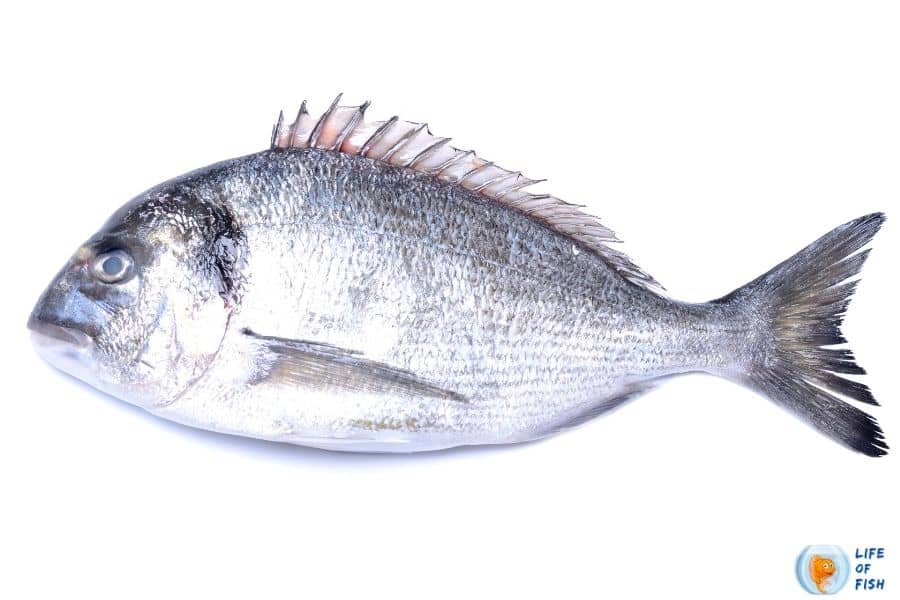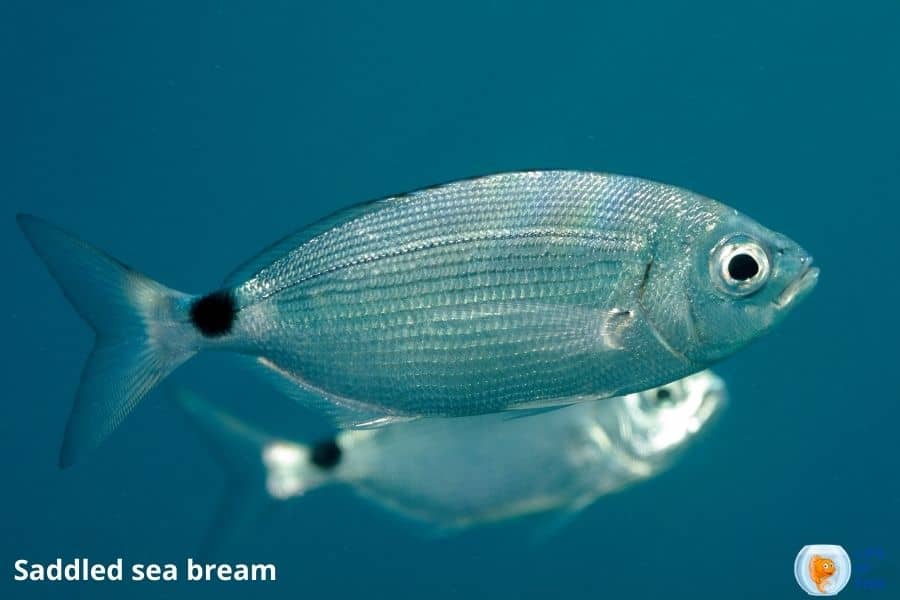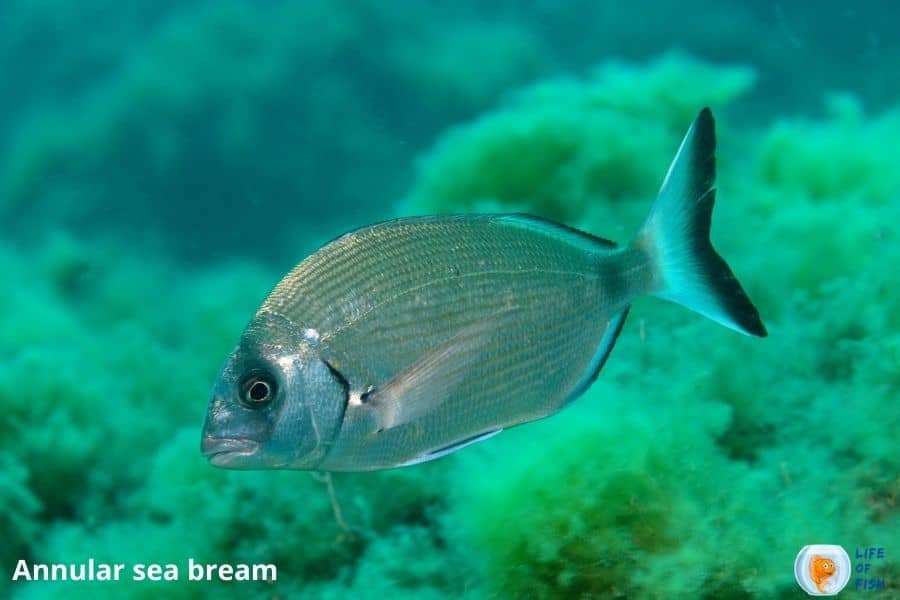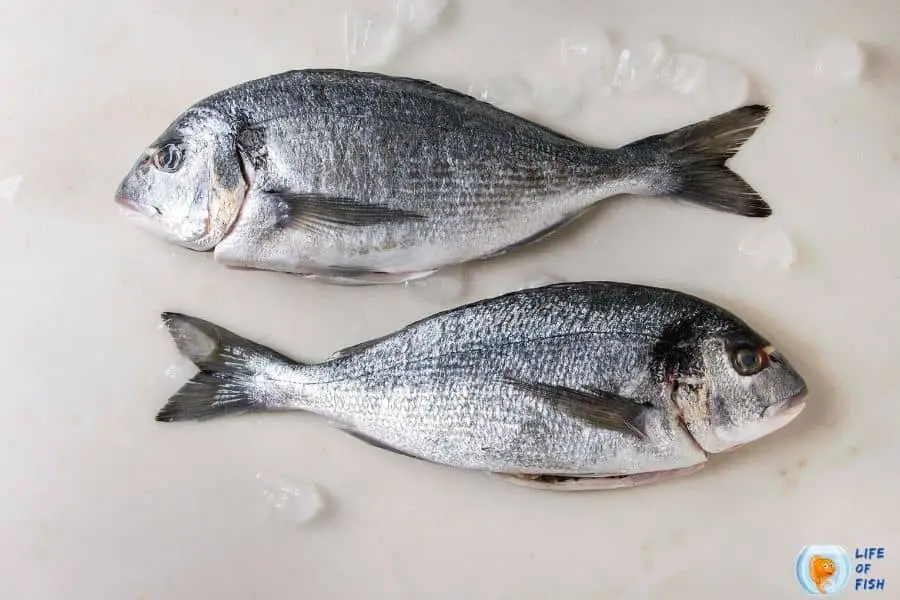Porgies are one of the common angling fish equivalent to bluegills and sunfish. They are fun to bait and easy to catch. Their aggressive behavior makes things more interesting as they fight frantically when hooked.
By reading this article, you can learn everything about porgy fishing, including tips and techniques used by seasoned anglers.

What is Porgy?
Jump To
- 1 What is Porgy?
- 2 Are Porgy bottom feeders?
- 3 Porgy Fishing Tips and Techniques
- 4 What is the best bait for Porgy?
- 5 How to Catch Porgies?
- 6 What are porgy rigs?
- 7 What is a Porgy Jig?
- 8 How do you make a jig for Porgy?
- 9 Can you catch Porgy at night?
- 10 Can you catch Porgy from shore?
- 11 Can you catch Porgy from deep water?
- 12 How to attach the bait?
- 13 Porgy Fish As Food
- 14 What does porgy fish taste like?
- 15 Related Questions
Porgy or Bream is any fish that belongs to the Sparidae family.
Porgy is the common name used in the USA, while sometimes they are called sea bream or scup.
There are about 100 species found throughout tropical and temperate marine waters worldwide.
They generally live in shallow waters, but a number of fish species live in deep waters.
Porgies typically range from ½ to 2 pounds, though there are fishes that weigh more than 3 pounds.
Pros consider them a trophy and have named them “humpbacks” and “dinner plates” due to their size and meaty humpbacks.
Are Porgy bottom feeders?
Yes, Porgies are carnivorous and feisty bottom feeders.
They possess grinding molar-like teeth that help them eat small fish, worms, and hard-shelled invertebrates like snails, crabs, and sea urchins.
These fish often tend to migrate and feed in schools, but some fish species prefer solitary.
Porgy Fishing Tips and Techniques
Since these are primarily shallow water fish, many people think that porgy fishing is easy.
Although these fish are an easy catch, you will have to know and plan a few more things before fishing.

Where do you catch Porgy?
Porgies love foraging on small crustaceans like barnacles and mussels, and these animals reside around sandy bottoms, rock piles, and reefs.
Therefore, you can find most porgies in these areas. Porgies usually stay behind the rocks and boulders to break the current and feed without spending much energy.
You can generally find these structures in deep sea, and bottom fishing is the best way to catch Porgy.
What is the best time to fish for porgies?
The best time for fishing is during warmer months of the year. These fish undergo an extensive migration during winter and summer.
To spend the winter, these fish swim offshore and then swim back to the coastal waters in the summer, from late April to early May.
From June to October, these fish stay in the shallow waters. As experts suggest, the best month to catch porgies is June.
Is it better to fish Daytime or nighttime?
The best time to fish for porgies differs according to certain areas. Most anglers prefer to fish in the daytime, while some prefer to fish at night.
In certain regions, porgies get caught at night, but it is easy to catch porgies in most waters in the daytime.

What is the best bait for Porgy?
Many anglers use sandworms and clams as bait. However, these fish are experts in stealing baits.
They are so aggressive that they will rip away the soft baits even before you get a chance to hook them.
And also, the cost of sandworms is a bit high. A less expensive bait alternative is squid.
Anglers prefer squid over sandworms not only because of its low cost but also its ability to hold onto a tide-swept hook and the ability to reuse the leftovers after refreezing.
Adding more baits will increase the chance of catching more fish but sometimes you will face problems unhooking multiple fish.
This is because of their sharp dorsal fin. So when you handling progies it is better to hold them from the stomach as many experienced fishermen do.
How to Catch Porgies?
There are several proven methods to catch porgies. One common way is anchoring over the structures that fish frequently stays while employing a chum pot loaded with clam chum.
For this, you can use a rig baited with sandworms or squid strips to maximize the fish amount.
Because of the chum pot, the fish school will come behind the boat. So, you get the chance to catch as many fish you want.
Another efficient strategy is to drift with the tide over the structure that is holding fish. Many reef systems are large and can house Porgy in a variety of locations.
These can be great places to drift fish because you can cover a lot of water and travel a long distance before having to resume your drift.
This can also be a brilliant approach to locate places that are home to larger-sized porgie schools.
When a huge fish is caught while drifting, mark the location on the GPS. Then, try to anchor over that region to maximize the size of your catch.

What are porgy rigs?
The Porgy rig is a specifically made leader with two or more hooks attached to catch more than one fish.
These rigs are made explicitly for medium-sized fish like porgies, snappers, and grunts.
One side of this rig attaches to the sinker, and the other side consists of a swivel to attach the leader to the mainline.
Between the swivel and the sinker, there are two or more loops attached to hooks. These hooks usually are about 6 inches long.
What is a Porgy Jig?
Porgy jig is a type of fishing lure. This jig consists of a hook with a molded lead sinker that is usually covered by a soft body (skirt) to attract fish.
The skirt creates a jerky, vertical motion in the water, and fish get attracted to it, thinking of living fish.
You can use the jig for both freshwater and saltwater fish as it is proven to outfish rigs.
How do you make a jig for Porgy?
Making a jig at home is not a good idea because you will have to work with hot lead, producing dangerous fumes and burning your hands.
For making a jig at home, you will need a hook, a melting pod, lead, paint, weed guard, and the desired skirt.
First, put the hook into the melting pod and pour hot lead on the top of the hook. Then remove the jig using pliers.
Let it cool. After painting the jig, connect the weed guard. At last, attach your desired skirt to the jig.
The process seems easy, but you need practice and patience when using the melting pot.
While you can make a jig for porgy fishing at home, we recommend buying one because they are dirt cheap at the market.

Can you catch Porgy at night?
Porgies are day and night feeders. So, if the area you are planning to fish in contains porgies, you can definitely catch Porgy at night.
Follow the same techniques you use in the daytime to catch porgies at night.
Some anglers reported that the porgies caught at night were bigger and more.
Can you catch Porgy from shore?
You can catch Porgy from shore. Most porgies live within casting distance in shallow waters on the sandy/gravel bottoms up to 30 feet deep.
These fish arent shy. So, they will come to the baits within minutes if they are near.
Pro anglers advise moving onto another place and re-anchor if you don’t catch a porgy within 10 minutes onshore.
The most common trick to catch more Porgy onshore is chumming. Chumming will help you bring more fish to your rigs by releasing small food particles into the current behind the boat.
Can you catch Porgy from deep water?
You can catch Porgy from the deep waters of some coastal regions.
Inshore waters like Long Island Sound or Buzzards Bay boast contains hot porgy spots in deepwater of 30 to 100m deep.
The anglers who go beyond shallow waters for porgy fishing are seasoned anglers. They often use the drifting technique to catch Porgy from deep water.
Rig or jig
Porgies travel in schools. Therefore, using a porgy rig can be more efficient if you want to catch more fish in less time.
Sometimes porgies do not eat the baits in rigs. But, this chance increases if you use a jig.
Jig color
When choosing a jig, you can pick any color you want as Porgies don’t seem interested in a specific color.
However, personal records confirm that red, orange, and yellow jigs seem to catch more fish.
Recommended fishing gear
Although porgies are relatively small fish, they are much aggressive that they pack a lot of punch and fight back when hooked.
While this can be a great angling experience, you need to have suitable equipment that can hold on while they struggle.
We recommend a 6.6′ to 7′ spinning rod rated for 14-20 pounds, a spinning wheel and fused line rated for the same weight range, a lure weigh up to 1 ounce, 30lb fluorocarbon leader, 4/0 beak bait hooks, 50lb barrel swivel, and a chum.
Finding the right bottom
Porgy fish tend to live in temperatures from 55 to 75 degrees Fahrenheit.
They usually appear in late spring when the temperate goes above the 60F mark. These fish typically stay in sandy and broken bottoms of about 6-120 feet deeps.
They usually move with the tide along sandy beaches when searching for food. Therefore you will also find them on sandy harbors and bays.
Chum tips
When choosing a chum, we recommend using at least one gallon of frozen chum. You should drop the pot to the bottom and tie it to the bow.
It’s essential to check the pot frequently if chum bait runs out or the scent gets washed out thoroughly.
Porgies will get interested in any chump, but clam chum is proven to work best.

How to attach the bait?
Since porgies are known to be bait stealers, you have to attach the bait carefully into the hook to prevent porgy stealing.
Porgies usually will respond to every kind of baits but usually prefer clams, sandworms, and squid.
You should cut 2 inches long narrow strips out of soft baits like clams and worms and thread them onto the hook multiple times.
If you use squid as the bait, threading it one to two times will be enough.
When threading the bait, be sure to leave a small part of bait to dangle beyond the hook so that more fish will get attracted to the bait.
Porgy Fish As Food
Is Porgy a good white meat fish to eat?
Porgy is a white meat fish to eat, and it is a fine eating fish suitable for baking, frying, broiling, even poaching.
It has a medium fatty white flesh, not too lean or not too oily. Porgy flesh has a sweet, delicate flavor, and the skin is also edible.
The taste is somewhat similar to snapper fish, but most seafood consumers have not tried this fish maybe because of its odd name.
Porgies are commonly cooked as whole fish. After scaling and gutting the fish, it gets seasoned with olive oil, garlic, salt, and spices.
Then, the fish gets grilled on each side for few minutes. When you serve the fish, squeeze it with some fresh lemon juice, and it will be both healthy and delicious.
Is Porgy fish high in mercury?
The Jersey Coast Anglers Association has reported low levels of mercury in porgy fish. Porgies contain about 0.08 parts per million mercury.
Compared to the high mercury fish, Mako Shark, which contains 2.09 parts per million mercury, this is still a very low amount.
So, Health Canada has listed Porgy as safe fish for pregnant women in amounts of 2.5 oz.

What does porgy fish taste like?
Porgy considers a good quality eating fish. Porgy fish has a medium fatty, white, tender flesh, not too lean or oily.
It tastes more like snappers with a sweet, delicate flavor. Its skin is also edible when scales are removed.
Eating this fish is not an easy task. They contain a lot of small bones. Therefore, this fish is not suitable for fillets.
Related Questions
Is Porgy a tilapia?
No. Tilapia is a group of freshwater fish species belongs to the family Cichlidae on Perciformes order.
They are native to Africa and easily raised around the world. Porgies are marine fish that belongs to the Sparidae family.
They live in the sea and are found throughout tropical and temperate marine waters worldwide.
So, although both fish types look similar, both species differ entirely from each other.
Is Porgy a saltwater fish?
Yes. Porgy is the common name used for any fish that belongs to the Sparidae family.
These fish live in the tropical and temperate marine waters around the world. They mostly live around shallow areas, but some species prefer to live in the deep sea.
Is Sea bass and porgy same?
No, sea bass belongs to the family Serranidae, and porgy belong to the family Sparidae.
Although porgy and sea bass are different fish types, they are sometimes found in the same fish catch.
Read Next:What Are Sharks Afraid Of? Cracking A Hidden Mystery
